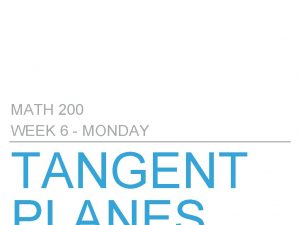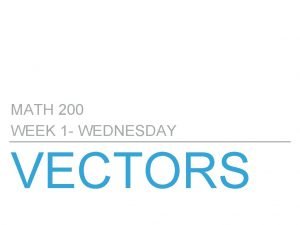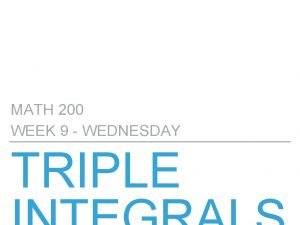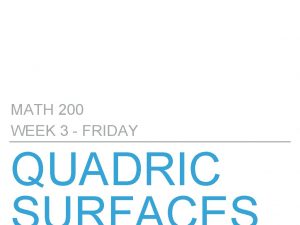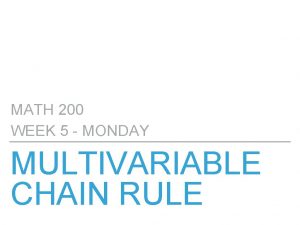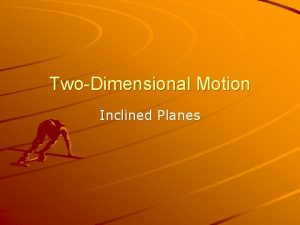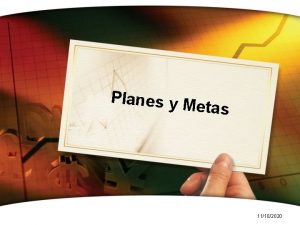MATH 200 WEEK 3 MONDAY PLANES MATH 200















- Slides: 15

MATH 200 WEEK 3 - MONDAY PLANES

MATH 200 MAIN QUESTIONS FOR TODAY ▸ How do we describe planes in space? ▸ Can we find the equation of a plane that satisfies certain conditions? ▸ How do we find parametric equations for the line of intersection of two (non-parallel) planes? ▸ How do we find the (acute) angle of intersection between two planes.

MATH 200 DEFINING A PLANE ▸ A line is uniquely defined by two points ▸ A plane is uniquely defined by three non-collinear points ▸ Why “non-collinear”? ▸ Suppose we have three points, A, B, and C in space… B A C

MATH 200 n B A C ▸ We can draw vectors between these points. ▸ We can find the vector orthogonal to both of these vectors using the cross product. ▸ This is called a normal vector (n = <a, b, c>) ▸ How does this help us describe the set of points that make up the plane?

MATH 200 n B P A C ▸ Consider a random point P(x, y, z) on the plane. ▸ If A has components (x 1, y 1, z 1), we can connect A to P with the vector AP = <x - x 1, y - y 1, z - z 1> ▸ The vectors AP and n must be orthogonal! ▸ n • AP = 0 ▸ <a, b, c> • <x - x 1, y - y 1, z - z 1> = 0

MATH 200 FORMULA ▸ So, given a point (x 1, y 1, z 1) on a plane and a vector normal to the plane <a, b, c>, every point (x, y, z) on the plane must satisfy the equation ▸ We can also multiply this out: IS CALLED POINT-NORMAL FORM FOR A PL

MATH 200 FIND AN EQUATION FOR A PLANE ▸ Let’s find an equation for the plane that contains the following three points: n B ▸ A(1, 2, 1); B(3, -1, 2); C(-1, 0, 4) A ▸ We need the normal: n C ▸ n = AB x AC ▸ AB = <2, -3, 1> and AC = <-2, 3> ▸ n = AB x AC = <-7, -8, -10> ▸ Point-normal using A: -7(x-1) - 8(y-2) - 10(z-1) = 0

MATH 200 COMPARING ANSWERS ▸ Notice that we had three easy choices for an equation for the plane in the last example: ▸ Point-normal using A: -7(x-1) - 8(y-2) - 10(z-1) = 0 ▸ Point-normal using B: -7(x-3) - 8(y+1) - 10(z-2) = 0 ▸ Point-normal using C: -7(x+1) - 8 y - 10(z-4) = 0 ▸ We also could have scaled the normal vector we used: ▸ -14(x-1) - 16(y-2) - 20(z-1) = 0 ▸ This makes comparing our answers trickier ▸ To make comparing answers easier, we can put the equations into standard form

MATH 200 ▸ Standard form: ▸ ax + by + cz = d ▸ Multiply out point-normal form and combine constant terms on the right-hand side ▸ E. g. ▸ Point-normal using A: -7(x-1) - 8(y-2) - 10(z-1) = 0 ▸ -7 x + 7 - 8 y + 16 - 10 z + 10 = 0 ▸ -7 x - 8 y - 10 z = -33 or 7 x + 8 y + 10 z = 33 ▸ Point-normal using C: -7(x+1) - 8 y - 10(z-4) = 0 ▸ -7 x - 7 - 8 y - 10 z + 40 = 0 ▸ -7 x - 8 y - 10 z = -33 or 7 x + 8 y + 10 z = 33

MATH 200 EXAMPLE 1 ▸ Find an equation for the plane in standard form which contains the point A(-3, 2, 5) and is perpendicular to the line L(t)=<1, 4, 2>+t<3, -1, 2> ▸ Since the plane is perpendicular to the line L, its direction vector is normal to the plane. ▸ n = <3, -1, 2> ▸ Plane: 3(x+3) - (y-2) + 2(z-5) = 0 ▸ 3 x + 9 - y + 2 z - 10 = 0 ▸ 3 x - y + 2 z = -1

MATH 200 EXAMPLE 2 ▸ Find an equation for the plane n = <? , ? > containing the point A(1, 4, 2) and the line L(t)=<3, 1, 4>+t<1, -1, 2> ▸ We need two things: a point and a normal vector ▸ Point: we can use A ▸ Normal vector: ? ? ? ▸ Draw a diagram to help <1, -1, 2> A (3, 1, 4) L WE’LL PUT ALL THE INFORMATION WE HAVE DOWN WITHOUT ANY ATTENTION TO SCALE OR PROPORTION

MATH 200 ▸ To get a normal we could n take the cross product of two vectors on the plane. ▸ We have one: <1, -1, 2> ▸ Form a second by connecting two points ▸ <-2, 3, -2> <1, -1, 2> A(1, 4, 2) (3, 1, 4) L

MATH 200 n = <-4, -2, 1> <1, -1, 2> A(1, 4, 2) (3, 1, 4) L ▸ Answer: ▸ Point-normal (using A): -4(x-1) - 2(y-4) + (z-2) = 0 ▸ Standard: -4 x - 2 y + z = -10 or 4 x + 2 y - z = 10

MATH 200 EXAMPLE 3 ▸ Find the line of intersection of the planes P 1: x-y+z=4 and P 2: 2 x+4 z=10 ▸ Start with a diagram: ▸ P 1 has normal n 1=<1, -1, 1> ▸ P 2 has normal n 2=<2, 0, 4>

MATH 200 ▸ Normal Vector: ▸ A vector parallel to the intersection will be orthogonal to both normal vectors. ▸ n = <1, -1, 1> x <2, 0, 4> = <-4, -2, 2> ▸ Point: ▸ a point in the intersection will satisfy both equations ▸ Because we have three variables and two equations, one variable is free - we can set one equal to a constant. ▸ Let z=0. Then we get ▸ x-y=4 and 2 x=10 ▸ So x = 5 and y = 1. ▸ Therefore, we have the point (5, 1, 0) common to both planes. ▸ Answer: L: <5, 1, 0> + t<-4, -2, 2>
 200 + 200 + 300
200 + 200 + 300 Enum days sunday monday=5 tuesday=6 wednesday=7
Enum days sunday monday=5 tuesday=6 wednesday=7 My favorite day is saturday
My favorite day is saturday Week by week plans for documenting children's development
Week by week plans for documenting children's development Art and music are my favorite subject
Art and music are my favorite subject Monday math class
Monday math class Did you finish your homework last night
Did you finish your homework last night 300 + 200 + 200
300 + 200 + 200 100 200 300
100 200 300 200+200+100+100
200+200+100+100 100 + 100 200
100 + 100 200 400+400+400+200
400+400+400+200 100 + 100 + 200
100 + 100 + 200 1
1 A visit to a doctor on monday текст перевод
A visit to a doctor on monday текст перевод British easter traditions
British easter traditions

















